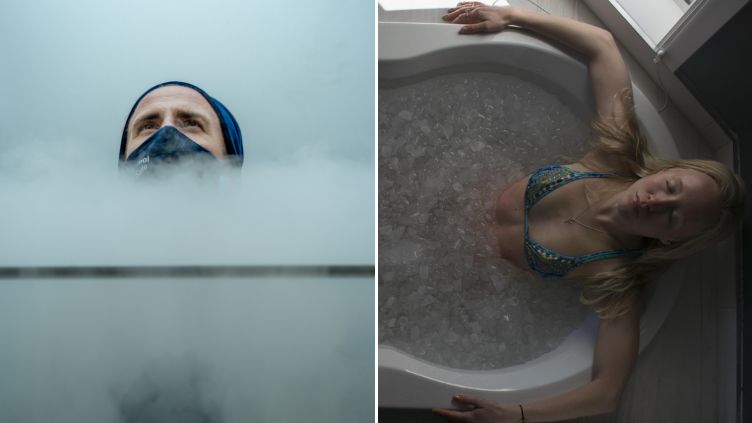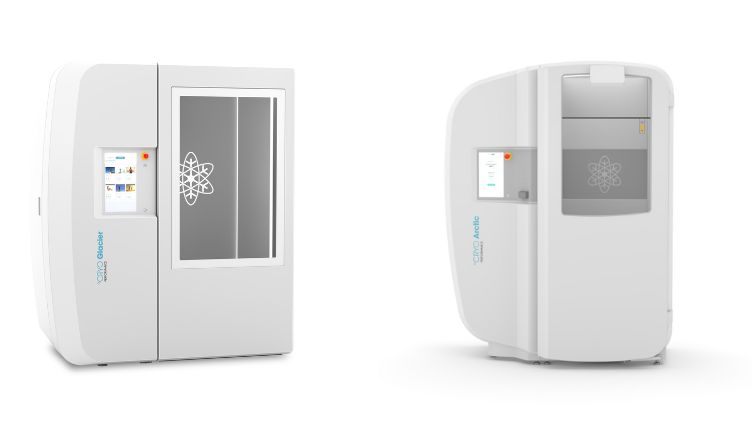An Icy Debate: Cryotherapy vs. Ice Baths
In the competitive world of sports, the importance of recovery cannot be stressed too much. The continuing argument between cryotherapy and ice bath mirrors a more extensive conversation about the best recovery methods in terms of effectiveness, efficiency, and cost. There are supporters and doubters of both approaches, so choosing one is not an easy task. Both cryotherapy and ice baths include being exposed to cold, but they work at vastly different temperatures. As a result, they produce unique impacts on the human body.
Temperature

Cryotherapy, which comes from the Greek word “cryo” for cold and “therapy” for cure, is a treatment that uses very sub-zero cold temperatures. Cold therapy has existed for many years and can range from basic ice packs to advanced cryosurgery procedures. Cryotherapy is based on a significant decrease in temperature to activate the body’s innate defense mechanisms.Cryotherapy and ice baths have differing impacts on the body due to their distinct processes. Cryotherapy involves exposing the body to temperatures as low as -110°C /166°F down to -140°C/-220°F for 2-3 minutes, causing a decrease in body temperature of approximately 40°F / 4°C.In contrast, an ice bath entails longer time durations of 30 seconds to 15 minutes, with temperatures ranging from a 46°F / 8°C and will reduce skin temperatures to around 70°F / 20°C after 3 minutes.
Why is this temperature drop so crucial in cryotherapy?
The extreme cold from cryotherapy activates the body’s thermoregulation response in the hypothalamus, which causes a few important things to happen:
- When exposed to extreme cold, the body enters into a fight or flight mode (survival mode), directing blood flow to the core and infusing it with nutrients and oxygen.
- This in turn safeguards vital organs, promotes organ performance, and rejuvenates cells. By constricting muscles and tissues, the body defends against hypothermia.
- The brain signals the body to send toxins to the lymphatic system to be expelled, cells begin a rapid renewal process, and dead cells are eliminated.
The profound impact of temperature drop in cryotherapy cannot be overstated. It initiates a cascade of defense mechanisms that safeguard core temperature.
But how does the temperature drop elicited from cryotherapy differ from that of an ice bath?
Cryotherapy surpasses ice baths in terms of frigidity and coverage. As a result, scientific studies have shown that cryotherapy is more effective in lowering skin temperature.
One study found: “Comparatively, while both treatments demonstrated a notable decrease in skin temperature from the initial baseline, whole-body cryotherapy induced a greater reduction compared to cold water immersion.”
Ice Baths expose the body to wet freezing cold temperatures

At a temperature of 46°F / 8°C during an ice bath, the body first attempts to warm the blood in the center of the body while still keeping the extremities warm.Extended time spent in an ice bath can result in actual freezing of the muscle tissue. As the chill seeps into the body, the muscles stiffen and ice over, beginning at the outer layer of skin and moving deeper inside. Prolonged periods in an ice bath could potentially lead to hypothermia, a serious condition that can be fatal.
On the other hand, cryotherapy does not actually freeze tissue; instead, it deceives our cold receptors into sensing a severe cold sensation when the skin briefly touches dry cold air. In cryotherapy, it is crucial to comprehend that the skin is not truly frozen. By exposing the skin to cryogenically cooled air, our cold sensors are activated to create the feeling of extreme cold instead. This doesn’t actually freeze the muscle tissue; instead, it deceives the nervous system into perceiving a sensation of freezing.
When the nervous system feels a strong freezing sensation, it quickly reacts, showing impressive reflexes to protect the body. In an ice bath, where the temperature is significantly lower, the brain’s initial reaction is to safeguard the extremities. In cryotherapy at temperatures of -110°C /166°F, the brain prioritizes the protection of essential organs over safeguarding the body’s extremities. The brain directs all limbs to tighten muscles and tissues in order to redirect blood to the body’s center.
As it moves through the body’s internal system, blood absorbs oxygen and essential enzymes and nutrients, becoming enriched in the process. This improved blood promotes the growth of internal organs, removes toxins from beneath the skin, renews cells, replaces damaged cells, and removes dead cells from surrounding tissues. This rejuvenation of the body at a cellular level is one of the key benefits of cryotherapy.
Safety – Hypothermia Risk
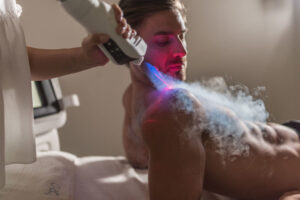
Cryotherapy cunningly simulates a freezing environment, deceiving the body’s sensory responses to cold without causing actual muscle tissue to freeze. In contrast, cold plunges can genuinely freeze muscle tissue, carrying with them the risk of hypothermia if the user stays in for too long. Cryotherapy does not involve freezing the skin or muscle tissue; instead, it deceives the body’s sensory responses to cold by simulating a freezing environment. This triggers a cascade of beneficial bodily responses, without crossing the line into tissue damage, causing actual muscle tissue to freeze.
This strategic approach means the treatment is safer and more controlled, offering a higher threshold of cold exposure without the risk of hypothermia or frostbite.Conversely, the cold plunge immerses the body in water that is cold enough to freeze muscle tissue. This direct contact with freezing temperatures is what gives ice bath their intense, muscle-stiffening character, and must be undertaken with caution due to the genuine risk of hypothermia with prolonged exposure.
Safety Precautions
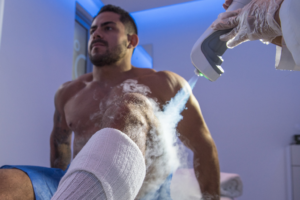
Further underlining the safety aspect, cryotherapy practitioners are vigilant about setting controlled time limits and having strict, supervised protocols in place to prevent users from pushing the body too far into a hypothermic state. This tailored approach ensures that individuals receive only the intended benefits of cryotherapy without any adverse reactions. °CRYO Science has done over millions of cryotherapy sessions without any safety incidents, showcasing the reliability and safety of our cryotherapy devices.
Comfort

Cryotherapy, known for its controlled dry air and 3-minute sessions, provides a less jarring conversion from warm to extreme cold and back again. Its lack of humidity reduces the risk of frostbite, and the individual’s core temperature remains warm, ensuring a comfortable and supervised experience without the threat of hypothermia. Many users report cryotherapy to be a much more comfortable and approachable experience in this regard. On the other hand, cold plunges, especially ice baths, can be a more intense and less predictable method of recovery. The process of plunging into freezing water presents a real shock to the system. While some athletes appreciate the mental strength it builds and its role in contrast therapy, others might find it too uncomfortable or even potentially hazardous.
Timing & Convenience
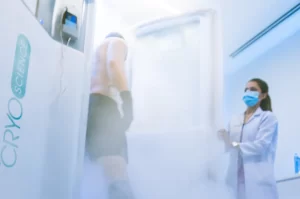
Cryotherapy is versatile enough to be incorporated into your fitness routine either before hitting the gym to enhance performance through increased alertness and circulation after your workout to accelerate recovery and reduce muscle soreness, or even both for comprehensive benefits. The user is completely dry during a cryotherapy session, making the session quick & convenient.Ice baths are usually saved for after your workout to allow for recovery time. As previously mentioned, extremely cold water can cause muscles to freeze and stiffen, so it’s important to take some time to relax after immersing yourself. Athletes and fitness enthusiasts must plan for this rest period to ensure muscles properly thaw and regain functionality, preventing the risk of injury stemming from rigid, cold-affected muscles. This inherent delay in recovery positions cold plunge as less conducive for those with a tight schedule or immediate physical engagements post-treatment.
Cryotherapy and cold plunges may both involve exposure to cold, but they operate at significantly different temperatures. Consequently, they elicit distinct effects on the human body.
- In terms of temperature reduction, which is the fundamental attribute of cold therapy, whole-body cryotherapy surpasses cold plunges by effectively lowering body temperature to 40°F compared to the more moderate 25°F achieved by cold plunges.
- This temperature drop elicits a more profound physiological response in the body, resulting in greater potential benefits.In regards to safety, cryotherapy takes the win.
- Unlike cold plunges, whole-body cryotherapy employs a method of temperature reduction that doesn’t involve the actual freezing of tissues, thereby ensuring a safer experience. Many users find cryotherapy to be more comfortable and approachable.
- Athletes are also able to use cryotherapy before and after a workout, while cold plunges can only be done after. Many people find cold plunge a better fit for contrast therapy. While we are firm believers in the safety and effectiveness of cryotherapy, it’s important to note that for certain types of severe muscular injuries, traditional cold plunges may prove to be more beneficial.
- Cold plunges are a more budget-friendly form of cold therapy, though cryotherapy memberships & °CRYO chamber financing can help to lower the cost of owning or utilizing WBC.
So- which are you opting for?


